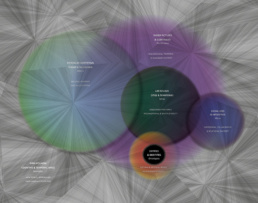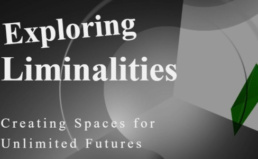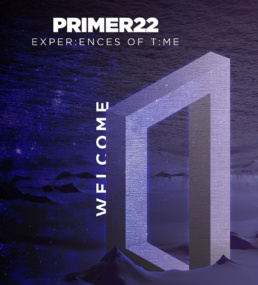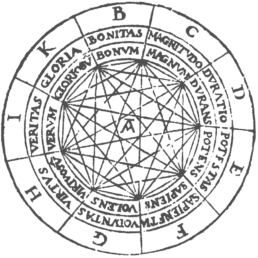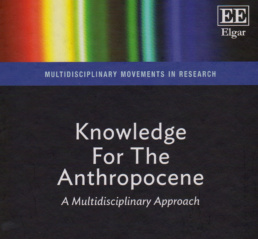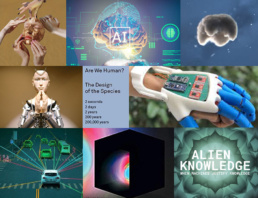Towards Alien Cosmologies,
Prospective of an epistemological refoundation
Essay and diagram, in Nova XX 2024 Biennale “Pluriverse and Contingency” catalog, Wallonia-Brussels Cultural Center, Paris, 2025
If the major transitions underway raise questions of unprecedented magnitude and shake the edifice of Western modernity, how can we rebuild an understanding of the world? And if these frameworks are deconstructed, how can we imagine new pluriversal cosmologies that give meaning to the world of today and tomorrow, but also allow radically different epistemologies to coexist and converse?
-
Combining foresight, artistic research, and post-humanist and post-colonial philosophies, the TAC Future Canvas serves here as a polygonal heuristic map to organize this dialogue by spatializing a diversity of perspectives on tangible and intangible worlds, and by introducing the horizon of the future.
-
Reintroducing the future into the world of knowledge also means giving space to the realm of possibilities, to speculation, to fiction, or even to artistic research to rethink these boundaries of the visible and construct new visions of the world.
About NOVA_XX 2024 ‘Plurivers & Contingency’ at Wallonia-Brussels Cultural Center, Paris, a biennial dedicated to artistic, scientific and technological interweaving in feminine and non-binary mode, and as part of the fourth industrial revolution / 4.0.
Biennale’s Manifesto by its curator Stéphanie Pécourt: The Biennale is dedicated to those who, under the banner of a coalescing and heterogeneous genre, were confined to the margins in the shadow of certainties.
NOVA_XX – liminal space – aims to highlight works and approaches that capture, critique, as much as they acknowledge and incorporate scientific and technological data.
Artworks that are strong in their capacity for decoincidence, for creating tension, and potentiating worlds not yet considered and sinusoidal cartographies. The Biennale de-sequences and is part of an aspiration to epistemic disobedience, in a critical reflection of the ethics of separation and dualisms, in an ode to the Pluriverse – plurality of heterogeneous worlds which reconciles as much nature and culture, as human and non-human. It is an ode to alien performativities, to the living in its incommensurable, and to research in its fundamental….
Download full Manifesto (in French).
Towards Alien Cosmologies, prospective of an epistemological refoundation
This article is a new episode of TAC Future Lab (Toward Alien Cosmologies), an artistic and future research project on the current paradigm shift, shaking the edifice of Western modernity, requiring an anthropological and epistemological refoundation, and calling for innovative pluriversal approaches to the future.
“How can we imagine future worlds when everything is ambiguous and uncertain!?” is its crazy and impossible fundamental question—a question that resonates particularly with the themes and the experiential, meliorist, and prospective universe of the Nova Biennale.
Faced with this dizzying challenge that goes beyond conventional comprehension and rationality, the lab has been exploring new, disruptive and open-ended paths since 2017, through hybrid, artistic and transdisciplinary approaches. This has given rise to creations (diagrams, installations, photomontages, etc.), publications, conferences, masterclasses, workshops, experiments and exhibitions in France and abroad. An online research journal traces all of the lab’s research episodes: tacfuturelab.org
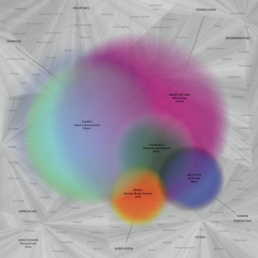
Polygonal Research
The TAC Future Canvas conceptual diagram, a new version of which is presented here, accompanies the lab’s experiments and investigations and is the subject of successive versions exhibited, published, presented or used in workshops. It serves as a mental map and a polygonal (multi-faceted) heuristic tool to envision, situate and explore a very broad spectrum of focal points and perspectives, whether spatio-temporal, conceptual, speculative, subjective, aesthetic or experiential, while remaining fluid and infinite.
The five spheres correspond to five scales to analyze the present world’s transformations and design future worlds, three of which belong to the domains of shared realities (micro, meso, macro), and two open onto invisible and more mysterious dimensions of being and of the universe (onto and cosmo). These five spheres are porous, interconnected, cloudy (each can be duplicated infinitely) and without borders or hierarchies. It is impossible to dissociate or define them, but they allow us to mentally spatialize a semioscape [1] and mark out an imaginary space where knowledge and visions of the world can appear and be mapped.
They draw a floating nebula in a polygonal and infinite background (extro) which puts them into perspective along numerous axes, whether cognitive or temporal, human or non-human (alien). This background forms an open space (Open Polygon) where can be situated a diversity of prisms – whether to analyze the forces moving the world today, to explore future worlds by positioning sets of hypotheses and projections (which is what future research does at different time scales and including historical perspectives) or to anchor, clarify and raise awareness of the cognitive and epistemological biases adopted.
The version of the diagram presented here emphasizes this last dimension, where a myriad of possible entry points, and a dizzying world unto itself, open up, resonating with the current epistemological reset mentioned before, as we shall see.
In this essay (which could be an infinite work), we will journey into this immaterial space and deepen this intersection between worldview, epistemological issues and the art of foresight, hoping to find some clarity there…
Future Worlds and the New Frontier of Foresight
Born at the turn of the second World War in Europe and the USA, Foresight is the field of investigation of future potentialities in all their dimensions, defined by one of its founding fathers, philosopher Gaston Berger [2], as an “anthropology of the future.”
Foresight opens, explores, constructs and questions very diverse future hypotheses. If some stand as futurological expressions (futures annunciations), this form of research (which is part of the broader field of Future Studies), remains fundamentally speculative and never pretends to engage in prediction or truth. Its methodologies constitute a peri-academic discipline and are the subject of numerous evolutions and experiments according to the future challenges facing society, organizations or institutions, and more broadly, humanity.
Foresight is thus a porous, plural and transdisciplinary practice, mobilizing knowledge from many academic fields (sociology, political science, economics, philosophy, environmental science, anthropology, digital technologies, humanities, psychology, neuroscience, theology, etc.) but also artistic fields (design, architecture, science fiction, art, performance, etc.).
The current paradigm shift and scope of critical future challenges, which foresight practitioners characterize by a whole range of concepts, – VUCA world (Volatile, Uncertain Complex and Ambiguous), Post-Normal Times, Deep Transition, Queer Futures, etc. – also challenges the historical methodologies and frameworks of Foresight.
This un/reframing of the discipline plays out in mirror with the anthropological and epistemological refoundation and reframing mentioned previously.
In the background of these three areas lies the question of how to reconstruct worlds and visions of the world, what we call here cosmologies, or etymologically, ways of ordering worlds and universes, and giving them sense and meaning – whether through scientific, philosophical, artistic or religious discourses.
As Isabelle Stenger reminds us [3] Modern science (and each of its disciplines) has formatted a certain vision and truth of the world, reduced to its observable phenomena, and following a logic of causality. Religions and mythologies do the same but differently. In fact, each epistemological framework, approach and even language (see keywords in the diagram), is an apparatus to format the world, a world that is nevertheless infinite, moving and immeasurable.
In a zoom out efforts towards the cosmological scale, it becomes possible to put into perspective, question and perhaps better develop or interconnect these epistemological frameworks in all their diversity, as a prerequisite for the outline of new pluriversal cosmologies and epistemologies.
Change of World, Transitions, and Ontological and Cosmological Boundaries
Before entering the topic of new worlds, let us briefly recall [4] the scope of future issues and how much they require the introduction of new perspectives (onto and cosmo scales), beyond socio-political and systemic changes (micro, meso and macro scales – i.e. the scales typically envisioned in foresight).
The Anthropocene and the environmental transition, which combine unprecedented transformation capacities and awareness of planetary limits, reunite the human and the non-human, and impose a reflection on planetary futures and on the long term, well beyond the framework of Western materialist rationality. As Arturo Escobar proposes in Designs for the Pluriverse, the ontologies and cosmologies of indigenous peoples are cognitive resources to be considered for understanding these perspectives and resetting [5] pluriversal worldviews and epistemologies.
At the same time, the demographic and post-colonial transition, this great movement of North-South rebalancing and crossbreeding of the globe, reintroduces into the spectrum of study, ontologies that are invisible, to the point of blurring the boundary between reality and what the West calls fiction. Philosopher Mohamed Amer Meziane shows in his latest work [6], how the Western anthropology of Latour and Descola, which nevertheless reconnects with animism – in fact a Western invention -, ignores the divine entities that populate the Muslim world, shape another order of reality, and contribute to its regime of truth.
Similarly, according to this metaphysics, the mental universe and, in particular, the unconscious, is not fabricated and enclosed in the human brain, but exists as one of the kingdoms of the world, eventually visited by these supernatural entities and forces. Many other discursive traditions and existential philosophies [7]— such as Buddhist cosmologies, for example —order the world into multiple visible and invisible realms with specific laws.
Finally, and third major global movement, technologies and the digital transition, generate again, like the two other transitions, multi-scalar impacts (micro – meso – macro), and contributes to the evolution of ontological, cosmological and epistemological schemes (onto – cosmo). AIs (artificial intelligences), these black boxes that challenge human rationality through opaque algorithmic reasonings and creative processes, are part of the new ontologies with which to make society, and shake up the mechanisms of truth-making.
The informational deluge that they exponentially accelerate with massive generation of fake but very real content, gives rise to the post-truth paradigm that, again, complicates the epistemological and cosmological refoundation in progress.
The digital sphere also introduces new ways of conceiving and thinking worlds that interest us.
On the one hand, the design of algorithms and the de-mining of their biases, are based on the “implicit world” inculcated into them, knowing that an AI has no prior sense of our world and its founding principles, starting with that of gravity. It is therefore necessary to give them what engineers call a “common sense”, that is, an ordering of a world (cosmology) that remains to be modeled. This requires, as for the era of the Anthropocene, a radical shift from the human-centric perspective to the alien’s and otherness in all its forms.
On another side of the digital transition, the emergence of virtual realities and persistent universes (metaverses) also gives rise to a proliferation of new worlds and immersive universes, drawing a cosmology of multiverses and supporting the design of future worlds, this time from the angle of imaginary worlds, as we will now see.
Imaginary Worlds and Universes
Although they are often united under the label of alternative worlds, the virtual and the imaginary worlds depicted in works of art and science fiction, are in reality quite distinct and will nourish our investigation in different ways. Literary and cinematic works of SF or even Cli – fi (Climatic Fiction), are intentionally turned towards the future, and are of particular interest to the field of foresight because they allow us to understand future hypotheses and risks, particularly on a planetary (macro) scale.
These rich and elaborate worlds, often staging a wide ontological diversity (numerous creatures), are constituted by physical laws (spatial-temporal regime and universe) and existential laws (modality and meaning of living together), which characterize their implicit cosmology. However, they remain fundamentally disjointed from the real world (fiction framework and “kingdom”).
And as Amelia Barikin points out in her essay “Making World in Art and Science-Fiction” [8], the possible worlds proposed by SF remain centered on the narrative thread, the experience of protagonists (micro), as well as on the human spectator entertainment expectations, which biases and limits the prospective investigation. On the contrary, she continues (quoting Bourriaud), the speculative and non-narrative worlds imagined by artists – the Nova Biennale being a perfect example – introduce hypotheses, models, and habitability conditions for future worlds.
On the other hand, remobilizing the contributions of Goodman [9], DiGiovanna [10] and then Suvin [11], she recalls how these fictional worlds, whether coming from SF or art, outline and offer the possibility of exploring alternative, human and non-human, terrestrial and extra-terrestrial, i.e. strange (alien) regimes of truth.
Although he does not cite these authors, philosopher Quentin Meillassoux shows in his work “Science Fiction and Extro-Science Fiction” [12] how Western Science’s entire edifice – starting with its core principles of observation and experience stated by Popper and criticized by Stenger among many other voices – is riveted to terrestrial reality and spatio-temporal regime, and attempts to emancipate from them through fiction thinking, as does SF.
But what happens when the fictional border, typical of Western universalism and humanism that split Art and Science to better work on them (and question them in relation to each other as we do here), no longer holds or simply does not exist as is the case in other epistemological traditions such as non-dualist ones? What pluriversalist alien cosmology would allow us to rethink and re-establish the cartography and architecture of this immaterial landscape with its multiple kingdoms, terrestrial and a-terrestrial?
Immersive and persistent virtual worlds such as video game universes, are, for their part, imaginary worlds that are not fictional but rather a-terrestrial (i.e. not subject to material and gravitational planetary constraints), are no longer disjointed from the real world, and constitute real life milieus (meso). Populated by an infinite spectrum of ontologies (avatars), shaped and governed by sets of rules independent from terrestrial laws, they multiply exploration potentials of space-time forms, habitability regimes and existential conditions [13], while being intimately intertwined with tangible human worlds. These virtual worlds, where millions of individuals act and dedicate important parts of their day, transform, distort or multiply contemporary planetary space-time, as well as its existential conditions, and become a multiverse. If each of its universes and nested worlds has its own cosmology – composed of a space-time typology, habitability conditions and an epistemological regime – what pluriversal cosmology makes them (would make them better) coexist?
In Search of New Epistemological Architectures
In her essay “In a Free Fall,” Hito Steyerl [14] questions the vertigo and disorientation that would be caused by abandoning the framework and epistemological foundations of Western humanism, constructed around an anthropocentric and geocentric perspective, both horizontal (lines of flight and linearity of time), and vertical (objectification of reality, spatial observation, and Man’s supervision). This deconstruction would in fact, most likely leave us in a stationary state floating in an infinite space, without top or bottom (extro), where maps of the world could be redistributed around a planetary justice prospect, and where new certainties could arise. Her words are tainted with a confidence in the future that is however not shared by everyone.
Another hypothesis put forward by futurist Ivana Milojevic [15] is that the questioning of the Western scientific framework, now perceived as far too instrumental and biased (systemic racism and sexism, relegation of the emotional as well as the invisible and the spiritual, etc.), is playing out in tandem with the rise of esoteric beliefs – the truth is hidden or inaccessible – in “invisible agents” at the heart of conspiracy theories. Doubt, at the center of the scientific project, turns into solid mistrust. In this regime of truth, “the die is cast” one might say, not without recalling that of religious discursive traditions or other demonization enterprises, which shift the boundary between true and false towards that of good and evil, and renounce the demonstration effort.
These sometimes very subtle shifts recall the complexity of post-truth challenges, the plasticity and porosity of knowledge ecosystems, and how much, in the background of the epistemological question, the question of worldviews and cosmological backgrounds is at stake. In her essay, Milojevic shows the necessity and importance of a form of anchoring in one (or more) regime(s) of truth to understand the present and explore the future.
However, there is no possible anchoring without an explicit base map – or else the anchoring remains hazardous, self-centered, and withdrawn into a bubble -, and this is indeed the challenge of the anthropological and epistemological reset currently underway. Similarly, in his work on transmodern pluriversalism, Dussel [16] invites us to free ourselves from Eurocentric foundations, while avoiding falling back into the pitfall of third-world or religious fundamentalisms of any kind. How then can we reconstitute a common base that is both open and plural?
In conclusion and opening, let us cite the work of Francesca Ferrando [17] who in her book Philosophical Posthumanism addresses both the critical challenge of post-colonial ontological diversity, and the multiverse – bridging its understanding in Western cosmology and in philosophy [18] – but, above all, introducing a posthumanist perspectivism that interests us.
If the philosophical perspectivism stated by Nietzsche – following Leibniz, and to which DiGiovanna also refers – tends to make all forms of truth disappear (everything is subjective, everything is relative, as postmodernism will also affirm later), she gives it a new meaning by crossing it with situated feminist epistemologies [19] and her reflections on post-humanist ontologies.
This new perspectivism consists of multiplying human and non-human perspectives, in order to better access the reality of the facts (which remain anchoring points), under different facets and according to different epistemes – and therefore much more in line with the post-colonial pluriversalism paradigm, the Anthropocene or the digital age.
As mentioned previously, it is according to this same approach (which we call polygonal) that the TAC Future Canvas is designed, which serves as a guide for adopting and situating a wide diversity of perspectives, vocabularies and approaches.
This artistic diagram also introduces the idea that the horizon of plural futures thus marked out, can constitute an epistemological axis and a common map of a new kind, forming an approximate conceptual topology, but in a stationary and shareable state.
Hybrid artistic research can particularly contribute to exploring, revealing and clarifying this cognitive and prospective landscape (futurescape) of an imaginal type [20]. If in his book “Ways of Worldmaking” Goodman circles around the rightness of created worlds in relation to reality (and locks himself into an epistemological impasse), we reopen and reorient this question in the vast speculative field of future hypotheses and potentialities, that is to say neither true nor false.
Thus, unlike Leibniz and Lewis who think of possible worlds as inaccessible and hermetically disjointed from our world, we reintroduce these possible worlds as contingent, present at the heart of our world, precisely in its imaginary and virtual dimensions. In this heuristic space of possibilities, a broad spectrum of disciplines, regimes of truth, and practices of (de)monstration can meet, be “verified” or questioned, prefiguring through a true artistic and generative blur both knowledge and future worlds, and resolutely becoming pluriversal multiverse.
Notes
[1] Semioscape diagram published in Menetrey, S. & Bidault-Waddington, R. (2016) Semiospace, a Spaced out artistic experiment, Clinamen editions, Geneva. This diagram takes up the principle of polygonal research initially designed for the Polygon project, exhibited and activated via a performative installation, in The Incidental Person (after John Latham), at Apex Art, New York, 2010.
[2] Berger, G. (1955). L’Homme et ses problèmes dans le monde de demain. Essai d’anthropologie prospective, republié dans Berger, G., Bourbon Busset, J. de, & Massé P., (2007). De la prospective : textes fondamentaux de la prospective française, 1955-1966, Harmattan.
[3] Stenger, I. (1997). Sciences et pouvoirs, faut-il en avoir peur ?, Labor.
[4] For more details, see our panoramas of contemporary world transitions in our conferences or in Designing Post-Human Futures (2021), in Carrillo, J. & Koch, G. (eds). Knowledge For the Anthropocene, E. Elgar Press, and Towards Alien Cosmologies, a Prospective Topology of an Anthropological Refoundation, in FuturHebdo Anthologies Prospectives #4, 2020.
[5] Escobar, A. (2018). Designs for the Pluriverse, Radical Interdependence, Autonomy, and the Making of Worlds, Duke University Press.
[6] Amer Meziane, M. (2023). Au bord des mondes, vers une anthropologie métaphysique, éditions Vue de l’Esprit.
[7] including Western, starting with Christianity which brings into existence the kingdom of heaven, hell and paradise, but also in contemporary and scientific cosmologies which mathematically formalize the existence of multiverses, or even the theory of imaginaries, as we will see later.
[8] Barikin, A., (2013). Making Worlds in Art and Science Fiction, in Cleland, K., Fisher, L. & Harley, R. (Eds.) Proceedings of the 19th International Symposium of Electronic Art, ISEA2013, Sydney.
[9] Goodman, N. (1978). Ways of Worldmaking, Hackett Publishing.
[10] DiGiovanna, J. (2007). Worldmaking as Art Form, The International Journal of Arts in Society, 2.1.
[11] Suvin, D. (1972), On the Poetics of the Science, Fiction Genre, College English, 34.3.
[12] Meillassoux, Q. (2013). Métaphysique et Fiction des Mondes Hors-Science, Aux Forges de Vulcain, Paris. English version: Science Fiction and Extro-Science Fiction, Univocal, 2015.
[13] The Transhumanism movement builds its theoretical edifice on these foundations, introducing, for example, notions of digital eternity beyond the limits of the human condition of existence.
[14] Steyerl, H. (2011). In Free Fall: A Thought Experiment on Vertical Perspective, e-flux Journal #24.
[15] Milojevic, I. (2020-23). Mirror, mirror on the wall, who should I trust after all? Future in the age of conspiracy thinking, unesco.eu.
[16] Dussel, E. (2009). Pour un Dialogue Mondial entre Traditions Philosophiques, in Cahiers des Amériques Latines #62.
[17] Ferrando, F. (2019). Philosophical Posthumanism, Bloomsbury Academic. See also his essay Toward a Post- Humanist Methodology, a Statement, published in 2012 in Frame, Journal for Literary Studies, Utrecht University, which we cited in Designing Post-human futures, ibid.
[18] This essay focuses on the triangle of epistemology, cosmology and foresight, and therefore we do not address here the diversity of space-time models, which is another aspect of the cosmological question.
[19] See Haraway’s many works, starting with Haraway, D. (1988). Situated Knowledges: The Science Question in Feminism and the Privilege of Partial Perspective. In Feminist Studies, Vol. 14, No. 3.
[20] Philosopher Henri Corbin defines the imaginal as an imaginary space of mental figuration, distinct both from the production of mental images mirroring reality, and from fictional imagination. See Corbin, H. (1964). Mundus imaginalis ou l’imaginaire et l’Imaginal, in Cahiers internationaux de Symbolisme #6.
Research Axes Reminder
Axis 1: Transitions & Future Worlds
Axis 2: Foresight Methodology Innovation
Axis 3: Art & Future Research
Related Articles
limit/no limit, Art & Design Research Conference, Paris, 2024
RBW zooms in on the TAC Future Lab work related to knowledge, whether it be the cognitive value of artistic formats,…
TAC World-building, 25th World Future Studies Federation Conference, Paris, 2023
This conference shows how the TAC Future Canvas was designed, how it rearticulates other tools and conceptual models…
Artistic & Polygonal Research on Time multidimensionality, PRIMER, 2022
Exploring the future also means questioning the temporal architectures and frameworks on which human life is…
Ethics & Philosophy of Futures, Association of Professional Futurists, 2022
RBW introduced here the different philosophical references that irrigate the work of TAC Future Lab, whether in its…
Designing Post-Human Futures, Knowledge for the Anthropocene, 2021
This long essay lays the basis of TAC Future Lab methodological and transdisciplinary research, mixing learnings from…
TAC, AI and the Human Frontier, Muzeum Susch Magazine, 2020
In this essay, RBW builds a bridge between the existential fear that gave its modernity to Heiddeger's thought in his…
